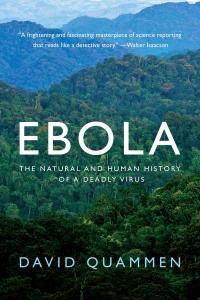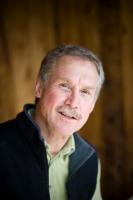David Quammen: Ebola
David Quammen
W.W. Norton, October 20, 2014. $13.95
ISBN: 978-0-393-351552
Quammen reports:
This is a book, as the subtitle indicates, about Ebola virus as an organism, seen through the perspectives of ecology and history: where it lives, how it lives, why it’s so dangerous and elusive, and what it has done to human victims over the past 38 years, since its first known emergence back in 1976.
Ebola is a zoonosis, meaning an animal infection transmissible to humans. I described the dynamics and implications of such species-leaping pathogens in my 2012 book, SPILLOVER, from which this new little book is largely derived.
EBOLA is intended to serve as a concise information resource for concerned citizens, media professionals, and public officials at an urgent time — amid this horrific 2014 outbreak that has become an epidemic in West Africa — as well as a literary work for the long term.
The book took shape in response to a request from my British publisher, Random House UK, and in particular from my two editors there, Stuart Williams and Katherine Ailes. As the outbreak in West Africa spun out of control, in late August, Katherine sent an email to my agent, Amanda Urban of ICM, suggesting that I create a stand-alone book on Ebola from the relevant sections in SPILLOVER.“What I would envisage,” Katherine wrote, “would be to lift the Ebola chapter in its entirety, with David providing a small amount of additional material.” After some initial disinclination (my desk was piled high with other projects), I embraced the idea roughly as Katherine had sketched it, but went a bit farther. In addition to the Ebola chapter from SPILLOVER, I added sections from other parts of that book, relating to bats as the reservoir hosts of Marburg virus, Ebola’s close cousin. I rearranged pieces, created new transitions, and wrote a new introduction and an epilogue, setting the subject within the context of 2014.
The tricky part of all this was combining carefulness with speed. I began work on August 30 (after finishing my duties as one of the judges of the NASW Science in Society writing awards for this year), with a deadline of September 10. I enlisted my trusted fact-checker, Emily Krieger, to jump into the effort and scrutinize every fact that she hadn’t already checked in working on SPILLOVER. I delivered the new text on September 9, and so my discussion of the 2014 epidemic is current to that point, with some grim projections of what might happen next. EBOLA appeared on October 2 in Britain, and on October 20 from W.W. Norton in the U.S. I hadn’t imagined, months earlier, that it was physically possible to shape, print, and publish a book so quickly.
And then, in early November, I went back to Africa on assignment for National Geographic to research another Ebola-related article. So the story continues. Alas, so does the epidemic.
Contact info:
- David Quammen: 406 539-0117, dq@davidquammen.com
- Agent: Amanda Urban, ICM Partners. 212 556-5764, AUrban@icmpartners.com
- Publicists: Louise Brockett, 212 790-4266, lbrockett@wwnorton.com; Johanna Ramos-Boyer, 703 646-5137, Johanna@jrbcomm.com
- Book website: http://www.davidquammen.com
- Blog website: http://www.davidquammen.com/dq-blog
NASW members: Will your book be published soon? Take advantage of this opportunity for shameless self-promotion.
Tell your fellow NASW members tell how you came up with the idea for your book, developed a proposal, found an agent and publisher, conducted research, and put the book together. Include what you wish you had known before you started working on your book, or had done differently.
See https://www.nasw.org/advance-copy-submission-guidelines.
Send info and images to Lynne Lamberg, NASW book editor, llamberg@nasw.org.




